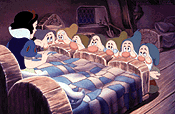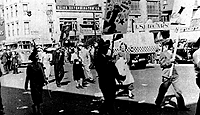Milestones Of The Animation
Industry In The 20th Century
(continued from page 2)
 |
|
Disney's
The Flying Mouse. © Disney.
|
1934 Disney's Playful Pluto
demonstrates cartoon characters can express that they are thinking.
Pluto is seen pondering a situation before he acts. In Disney's
The Flying Mouse (also 1934), pathos is demonstrated eloquently.
Both films demonstrate the studio's level of sophistication.
1934 The illusion of depth is first achieved by the Fleischers
using table top animation in Poor Cinderella with Betty Boop.
Ub Iwerks used his multiplane system in The Cave Man with
Willie Whopper (1934). Disney's elaborate multiplane system is first
seen in The Old Mill, 1937.
1935 Inker Sadie Bodin is fired from the Van Beuren Studio
for union activities. She is the first to picket an animation studio.
1936 Len Lye's A Colour Box and Kaleidoscope
(1936) are the oldest existing films made by hand painting directly
onto film stock. Other artists had used the technique, but none
of their work exists.
 |
|
Disney's
Snow White. © Disney.
|
1937 The artistic and financial success
of Disney's Snow White showed others it was possible to make
a successful animated feature.
 |
|
The
1937 strike at the Fleischer Studio. Courtesy of Tom Sito.
© Motion Picture Screen Cartoonists Union Local 839.
|
1937 The industry's first major strike
was at the Fleischer Studio in New York. The strike lasted over
5 months. It resulted in higher wages and better benefits.
1940 Disney's Fantasia
introduces Fantasound, a multi-channel stereo sound system. Only
6 theaters were equipped to play Fantasound. It was one of the first
(but not the first) films with a stereo soundtrack.
1940 George Pal moves from The Netherlands to the U.S. In
Europe he developed his craft doing theatrical advertisements. Now,
Paramount was paying him to do theatrical shorts.
1941 Otto
Messmer, creator of Felix the Cat, animates the world's first
TV commercials, a series of Botany Tie ads/weather reports. They
were shown on NBC-TV in New York until 1949. They were produced
by Douglas Leigh. (The station went commercial in 1941.)
 |
|
The
1941 strike at Disney. Courtesy of Tom Sito. © Motion
Picture Screen Cartoonists Union Local 839.
|
1941 The strike at Disney was probably
the industry's most devastating labor crisis. Although the strikers
won, almost all were eventually laid off or quit. Most went on to
bigger and greater things. (The 1947 strike at Terrytoons, which
lasted 8 months, shares this dubious honor of being the industry's
most devastating blow to labor.)
1941 Federal legislation gave most workers a 40 hour work
week in 1913, but the animation industry didn't get the 40 hour
week until 1941. Studios gave up mandatory Saturday work (a 46 hour
work week) in 1941 in a final attempt to avoid unionization.
1941 Norman McLaren begins his long
career with the National Film Board of Canada.
1941 Leon Schlesinger's biggest mistake may have been his
reaction to a fight with Tex Avery about the ending of Heckling
Hare. Schlesinger fires Avery and MGM hires him to head his
own unit. The rest, as they say, is history.
 |
|
Disney's
Song of the South. © Disney.
|
1946 Protests over the depiction of
Black people in Disney's Song of the South marks the beginning
of the trend toward politically correct animation.
1948 Columbia gives UPA a contract to make 4 theatrical cartoons.
The success of these shorts directed by John Hubley, resulted in
UPA finding a permanent home with Columbia. This ensured support
for their innovative "modern" approach to animation.
1949 The Supreme Court ends the "block booking"
practice by film distributors/studios. This results in the eventual
end of the theatrical cartoon industry in the U.S.
1950 Crusader Rabbit, created by Alex Anderson and
produced by J. Ward, airs on TV in Los Angeles. It was the first
limited animation cartoon made for the small screen. The show lasted
5 minutes (including 90 seconds of commercials).
1950-51 Norman McLaren is commissioned to make two 3-D stereo
films for The Festival of Britain. Now is the Time is the
title and also the opening line of one of the films. It is followed
by "to put on your glasses" (Polaroid glasses). The second
film, Around is Around, was the first film made using an
oscilloscope to generate patterns. Both 3-D films were also designed
with stereo soundtracks. Both were 10 minutes long.




